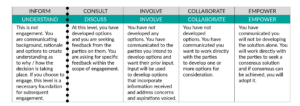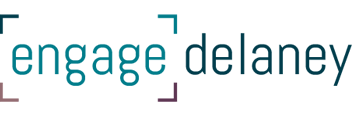Explaining the Spectrum to Decision Makers
by Richard Delaney, President, Delaney, the engagement people
You will find below several points you may want to consider when explaining the engagement spectrum to a decision maker.
Public, community or stakeholder engagement is the process by which those impacted by a decision are brought into the decision-making process, in order to create understanding and give influence. The most cost-effective approach to risk and change management – particularly when negative impacts are projected, or perceived – is to share decision making with those impacted. The degree of sharing, or intensity of engagement, is a key to success and also the essence of authentic engagement.
Engagement is a support function to decision making. Authentic engagement is integrated into the decision-making process, so that no parts of the decision that impact different parties are made without the opportunity for engagement. In most decision processes, there is a point at which options or alternatives for a final decision are formulated. This “options development phase” is absolutely not the only place to engage interested and affected parties, but it is a good point of reference when explaining what different levels of the spectrum mean.
Engagement is not a switch that gets turned on or off. There are ranges of influence the decision maker should commit to based on the significance of the impact. I like to use the word “intensity”. The more negative the impact, the more intently the decision maker should listen and share decision influence.
The table below helps you explain the concept of intensity using the IAP2 Spectrum of Public Participation. This is an international model, so should be considered a generic framework requiring adaptation. In the Canadian context, it would be considered the “Spectrum of Engagement” and the names for the different levels should be changed, as I suggest in the second row.

It is important to take the time to establish the conditions for effective engagement:
- Create understanding in both directions.
- Work only within the scope of engagement.
- Articulate the givens clearly.
- The decision maker is part of the consensus process.
- Focus on a discreet set of decision aspects.
- You will work at different levels of the spectrum across the decision process.




